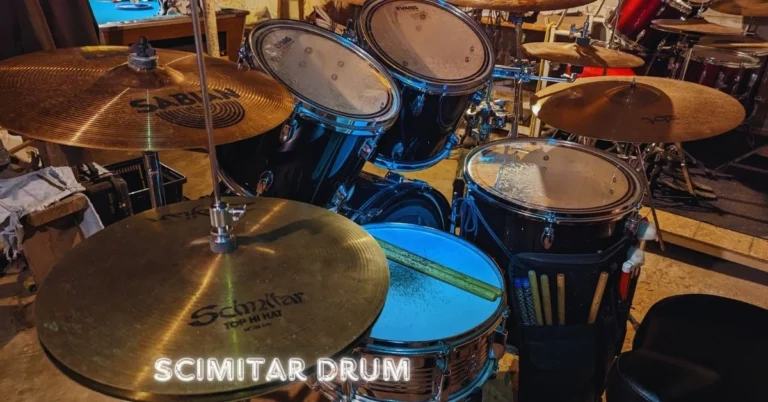Introduction
The scimitar drum, a captivating instrument with a rich history and unique design, has fascinated musicians and historians alike. Named for its resemblance to the scimitar sword, this percussion instrument is notable for its distinctive shape and sound. Its origins and development reflect a blend of cultural influences, showcasing its role in both traditional and modern music.
Historical Origins
The scimitar drum has roots in ancient cultures, particularly those from the Middle East and North Africa. Its shape, reminiscent of a curved scimitar blade, suggests influences from the regions where such weapons were commonly used. Historical records and archaeological findings indicate that variations of the scimitar drum have been used in ceremonial and military contexts for centuries.
Design and Construction
The design of the scimitar drum is unique. Its body typically consists of a curved or crescent-shaped frame, often made from wood or metal. The drumhead is stretched across the open end of the curve, creating a distinctive, resonant sound. Traditional scimitar drums are handcrafted, with artisans paying meticulous attention to the materials and construction techniques to ensure optimal sound quality.
Cultural Significance
In various cultures, the scimitar drum holds significant cultural and ceremonial importance. In Middle Eastern music, it is often used in traditional performances and religious ceremonies. Its sound is believed to have spiritual and symbolic meanings, making it a vital component of cultural rituals. The drum’s design also reflects the aesthetic values of the cultures from which it originates.
Regional Variations
While the scimitar drum is commonly associated with the Middle East, variations of this instrument can be found in other regions. In North Africa, for example, the drum may have different sizes and tuning systems, reflecting local musical traditions and preferences. These regional variations contribute to the diverse soundscapes created by the scimitar drum across different cultures.
Construction Techniques
The construction of a scimitar drum involves several steps. First, artisans select high-quality materials for the drum body and head. Wood, metal, and synthetic materials are commonly used. The drum’s frame is crafted into its characteristic curve or crescent shape, with attention to detail in the curvature and balance. The drumhead is then stretched over the frame and secured, often with animal skin or synthetic materials.
Sound Characteristics
The scimitar drum produces a distinctive sound that sets it apart from other percussion instruments. Its curved shape allows for a resonant, deep tone with a pronounced bass quality. The drum’s sound can vary depending on its size, the materials used, and the playing technique. This versatility makes it suitable for a range of musical styles, from traditional to contemporary.
Playing Techniques
Playing the scimitar drum involves various techniques to achieve different sounds and rhythms. Drummers may use their hands, sticks, or mallets to strike the drumhead, with each method producing distinct tonal qualities. Techniques such as finger taps, rim shots, and rolls are employed to create intricate rhythms and textures. Mastery of these techniques requires practice and skill, making the scimitar drum a challenging and rewarding instrument to play.
Role in Traditional Music
In traditional music, the scimitar drum plays a crucial role in providing rhythm and texture. It is often used in ensemble settings, where its unique sound complements other instruments. In Middle Eastern and North African music, the drum’s rhythms are integral to the overall musical structure, often accompanying dance and vocal performances. The scimitar drum’s ability to blend with other instruments while standing out with its distinct tone makes it a valuable asset in traditional music.
Modern Adaptations
In contemporary music, the scimitar drum has been adapted and incorporated into various genres. Musicians and composers have experimented with its sound, integrating it into modern ensembles and performances. This adaptation has led to new interpretations of the drum’s role, expanding its presence beyond traditional settings. Modern scimitar drums may feature electronic elements or hybrid designs, reflecting the evolving landscape of contemporary music.
Preservation and Revival
Efforts to preserve and revive the scimitar drum have been ongoing, particularly in regions where it holds cultural significance. Organizations and musicians are dedicated to maintaining traditional techniques and promoting awareness of the instrument. Workshops, performances, and educational programs aim to keep the scimitar drum’s legacy alive, ensuring that future generations can appreciate and continue its use.
Notable Performers and Ensembles
Several notable performers and ensembles have contributed to the scimitar drum’s prominence in the music world. These artists have showcased the drum’s versatility and unique sound, often blending it with other instruments and styles. Through their performances and recordings, they have highlighted the scimitar drum’s potential and elevated its status within both traditional and contemporary music scenes.
The Scimitar Drum in Popular Culture
The scimitar drum has also made its mark in popular culture, appearing in films, television shows, and other media. Its distinctive appearance and sound make it a compelling visual and auditory element, often used to evoke themes related to its cultural origins. This presence in popular culture has further expanded the drum’s reach and influence, introducing it to new audiences.
Challenges and Opportunities
Despite its rich history and unique qualities, the scimitar drum faces challenges in the modern world. Its traditional construction techniques and materials may not always align with contemporary manufacturing practices. However, these challenges also present opportunities for innovation and adaptation. By embracing new technologies and approaches, the scimitar drum can continue to evolve and thrive in the ever-changing landscape of music.
Conclusion
The scimitar drum stands as a testament to the rich musical and cultural traditions from which it originates. Its unique design, distinctive sound, and historical significance make it a fascinating instrument with a storied legacy. Whether used in traditional ceremonies or modern compositions, the scimitar drum continues to captivate and inspire musicians and audiences alike. As efforts to preserve and adapt the drum continue, its influence is likely to endure, bridging the gap between past and present musical expressions.
Read More: Vioprow: A Revolution in Modern Technology







